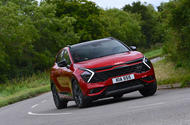Sportage is one of Kia’s top-selling hybrid models currently
Kia to launch nine electrified models by 2028 and forecasts hybrids will make up 20% of its sales in 2030
Kia will add more hybrid cars to its ranks over the coming years in response to faltering global uptake of electric cars.
In a bid “to manage fluctuation in EV demand” and to cater for a forecasted increase in sales of electrified combustion cars, Kia will launch nine new hybrids by 2028 “across most major model lines globally”.
It didn’t say which model lines specifically will be hybridised, nor did it say whether the total includes both full hybrids and plug-in hybrids.
The Korean brand’s objective of selling 1.6 million electric cars annually by 2030 is unchanged, it said at its annual investor conference yesterday, but it acknowledges that EV sales growth is “slowing due to economic downturn, subsidy cuts and lack of charging infrastructure”.
In light of that, Kia forecasts that hybrids will make up 20% of its global sales in 2030 – up from an estimated 14% in 2024. Its proportion of EV sales will rise from 10% to 38% over the same period, it estimates.
Overall, electrified vehicles are estimated to account for 58% – or roughly 2.48 million units – of Kia’s global sales by 2030.
However, those percentages vary significantly according to different regions. In the US and Canada, for example, Kia forecasts that 35% of its sales will be hybrids in 2030, while that figure will be just 12% in the EU.
In Kia’s home market of Korea, hybrids are expected to be the best-selling form of powertrain at the end of the decade, taking 43% of the brand’s sales, compared with 41% for EVs and just 16% for pure-ICE cars.
Hybrids currently account for just 1% of Kia’s sales in China, and it will stop selling them there completely by 2030, leaving it with a 53:47 sales split between EVs and pure-ICE cars.
Kia has also pledged to develop a new generation of hybrid powertrain with “enhanced power and fuel efficiency” in a bid to “diversify” its product offering.
There will be two versions of this new powertrain: one for “subcompact and mid-sized” cars and another for large vehicles.
“To ensure cost competitiveness and production flexibility”, Kia will build the new hybrid powertrains alongside its existing combustion engines.
Ho Sung Song, Kia president and CEO, said: “Following our successful brand relaunch in 2021, Kia is enhancing its global business strategy to further the establishment of an innovative EV line-up and accelerate the company’s transition to a sustainable mobility solutions provider.
“By responding effectively to changes in the mobility market and efficiently implementing mid-to-long-term strategies, Kia is strengthening its brand commitment to the wellbeing of customers, communities, the global society and the environment.”
Kia will nonetheless continue to expand its EV offering over the coming years. It will launch six new such models by the end of 2026: the EV2, EV3, EV4, EV5, updated EV6 and hot GT version of the EV9.
Meanwhile, it will launch its new line of PBV electric vans in late 2025, beginning with the mid-sized PV5 (due in Europe in early 2026) and expanding with the larger PV7 in 2027. It aims to sell 250,000 PBVs by 2030.
A new generation of EV battery planned for production in 2025 is said to increase energy density by 7% and reduce costs by 10% compared with current models, Kia said.
It also confirmed plans to use different battery chemistries in different markets – “including NCM [nickel-manganese-cobalt] and more affordable LFP [lithium-iron-phosphate] chemistries”.
Source: Autocar
